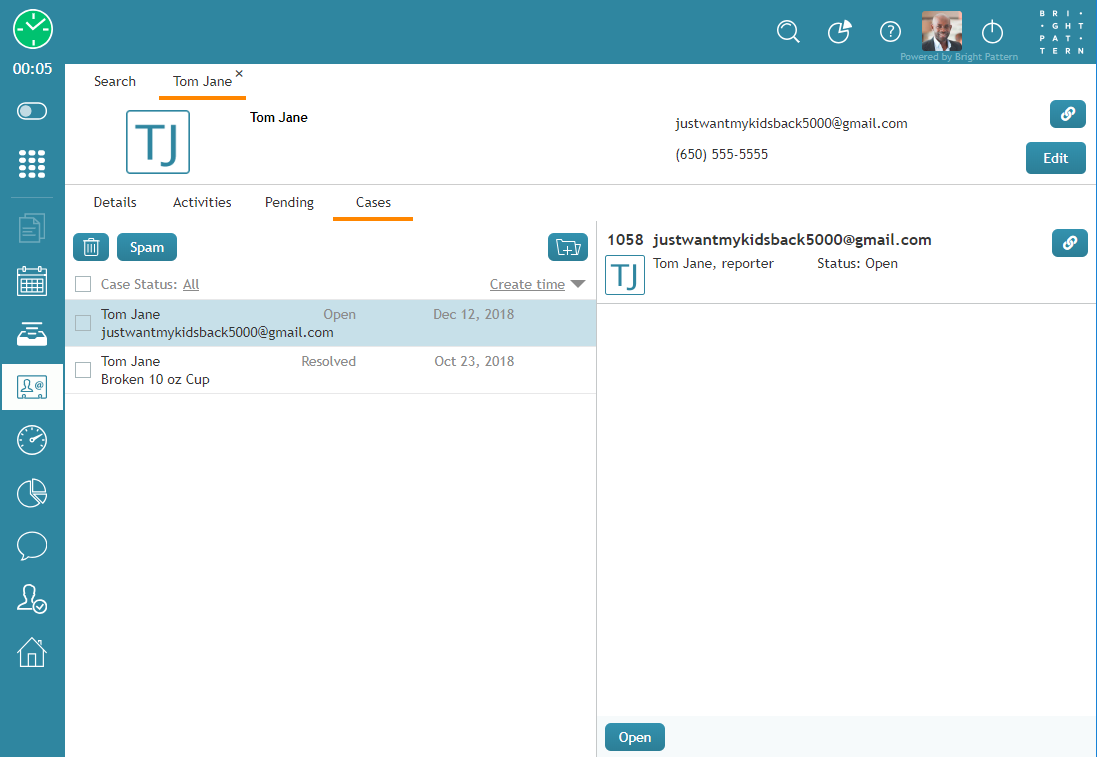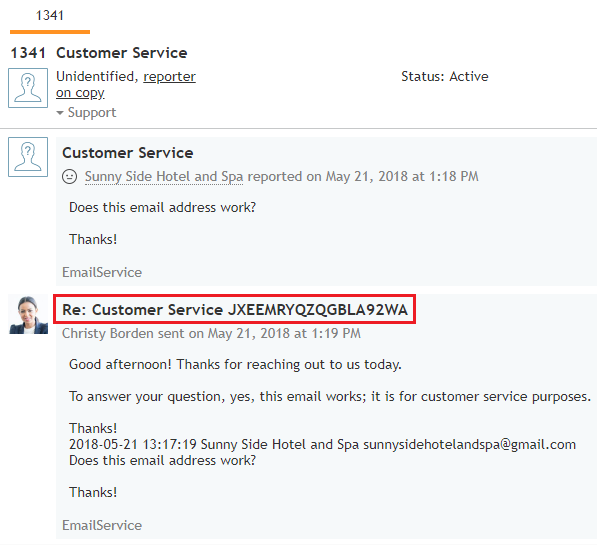(Updated via BpDeleteTranslateTags script) |
|||
| (9 intermediate revisions by 3 users not shown) | |||
| Line 1: | Line 1: | ||
| − | + | = Cases, Email, and Threads = | |
| − | In Agent Desktop, [[Agent-guide/WhatIsAgentDesktop|interactions]] can be associated with a ''case'', be an ''email'', and | + | In Agent Desktop, [[Agent-guide/WhatIsAgentDesktop|interactions]] can be associated with a ''case'', be an ''email'', and be associated with a ''thread''. But what are the differences between these things? In this article, we explain the differences between cases, email, and threads. |
| − | |||
| − | |||
| − | + | [[File:Create-Case-Without-Interaction-3-53.PNG|800px|thumbnail|center|A history of cases associated with a saved contact in section Search & Preview Records]] | |
| + | == Cases and Email == | ||
| + | A case is an instance of customer service that is created to track all communications related to a specific customer request. Cases can be [[Agent-guide/HowtoCreateNewCases|created manually]] in your contact center or automatically if they arrive there as email. By contrast, email is a specific type of [[Agent-guide/WhatIsAgentDesktop#Supported_Channels|channel]] customers use to interact with your contact center. In short, all emails are cases but not all cases are emails. | ||
| − | + | When cases are created or emails arrive, the system automatically assigns a number to the case/email that is unique within your contact center (e.g., ''14355''); it is maintained as an active entity while the request is being worked on, and closed when the request is fulfilled. When email arrives at your contact center, it is directed to section [[Agent-guide/Work/CasesEmail/MyCasesInterface|My Cases]]; cases, on the other hand, can be created and found in [[Agent-guide/HowtoCreateNewCases|various sections]] of Agent Desktop. | |
| − | + | Cases and emails can be assigned a [[Agent-guide/Work/CasesEmail/CaseStates|case state]], which indicates what the state of completion the interaction is in. Additionally, cases and emails can be assigned [[agent-guide/HowtoEnterDispositionsandNotes|dispositions]]. Dispositions are interaction results defined by your contact center management are used to indicate how the interaction was completed; your system administrator will explain how to use dispositions. | |
| − | + | For more information, see [[Agent-guide/HowtoCreateNewCases|How to Create New Cases]], [[Agent-guide/Work/CasesEmail/MyCasesInterface|My Cases Interface]], and [[Agent-guide/Work/SearchandPreviewRecords/SearchandPreviewInterface|Search & Preview Records Interface]]. | |
| + | == Threads == | ||
| + | A group of emails related to the same case is called an email thread. When you reply to a customer’s request for the first time, the system will generate a unique thread identifier. Depending on your system configuration, this identifier may be either attached to the email subject or hidden in an email header. Unlike the case number, the email thread identifier may contain both numbers and letters (e.g., JXA6PDRNQ2SO) and is intended primarily for automatic processing. | ||
| − | + | For example, when a new email comes in, the system will look for a thread ID and check if it matches any of the existing cases. If a thread ID is found and recognized, the system will automatically assign that email to the corresponding case. Depending on your service configuration, the system also may attempt to deliver that email to you if you have previously worked on this case. | |
| − | + | Threads primarily contain the text of all email messages exchanged within the case. Additionally, threads contain the following email header information: | |
| − | + | * '''From''' - The display name, if available, and the raw email address of the sender | |
| − | + | * '''When''' - The date and time when the email was sent or received | |
| − | + | * '''To''' - The display names, if available, and the raw email addresses of the recipients in the TO section | |
| − | + | * '''Cc''' - The display names, if available, and the raw email addresses of the recipients in the CC section | |
| + | * '''Subject''' - The subject that that message was sent/received with | ||
[[File:Email-Headers-50.PNG|450px|thumb|center|When you reply to an email, a thread ID is added to the email subject]] | [[File:Email-Headers-50.PNG|450px|thumb|center|When you reply to an email, a thread ID is added to the email subject]] | ||
| − | |||
| − | |||
| − | |||
| − | |||
| − | |||
Latest revision as of 04:01, 29 May 2024
Cases, Email, and Threads
In Agent Desktop, interactions can be associated with a case, be an email, and be associated with a thread. But what are the differences between these things? In this article, we explain the differences between cases, email, and threads.
Cases and Email
A case is an instance of customer service that is created to track all communications related to a specific customer request. Cases can be created manually in your contact center or automatically if they arrive there as email. By contrast, email is a specific type of channel customers use to interact with your contact center. In short, all emails are cases but not all cases are emails.
When cases are created or emails arrive, the system automatically assigns a number to the case/email that is unique within your contact center (e.g., 14355); it is maintained as an active entity while the request is being worked on, and closed when the request is fulfilled. When email arrives at your contact center, it is directed to section My Cases; cases, on the other hand, can be created and found in various sections of Agent Desktop.
Cases and emails can be assigned a case state, which indicates what the state of completion the interaction is in. Additionally, cases and emails can be assigned dispositions. Dispositions are interaction results defined by your contact center management are used to indicate how the interaction was completed; your system administrator will explain how to use dispositions.
For more information, see How to Create New Cases, My Cases Interface, and Search & Preview Records Interface.
Threads
A group of emails related to the same case is called an email thread. When you reply to a customer’s request for the first time, the system will generate a unique thread identifier. Depending on your system configuration, this identifier may be either attached to the email subject or hidden in an email header. Unlike the case number, the email thread identifier may contain both numbers and letters (e.g., JXA6PDRNQ2SO) and is intended primarily for automatic processing.
For example, when a new email comes in, the system will look for a thread ID and check if it matches any of the existing cases. If a thread ID is found and recognized, the system will automatically assign that email to the corresponding case. Depending on your service configuration, the system also may attempt to deliver that email to you if you have previously worked on this case.
Threads primarily contain the text of all email messages exchanged within the case. Additionally, threads contain the following email header information:
- From - The display name, if available, and the raw email address of the sender
- When - The date and time when the email was sent or received
- To - The display names, if available, and the raw email addresses of the recipients in the TO section
- Cc - The display names, if available, and the raw email addresses of the recipients in the CC section
- Subject - The subject that that message was sent/received with


